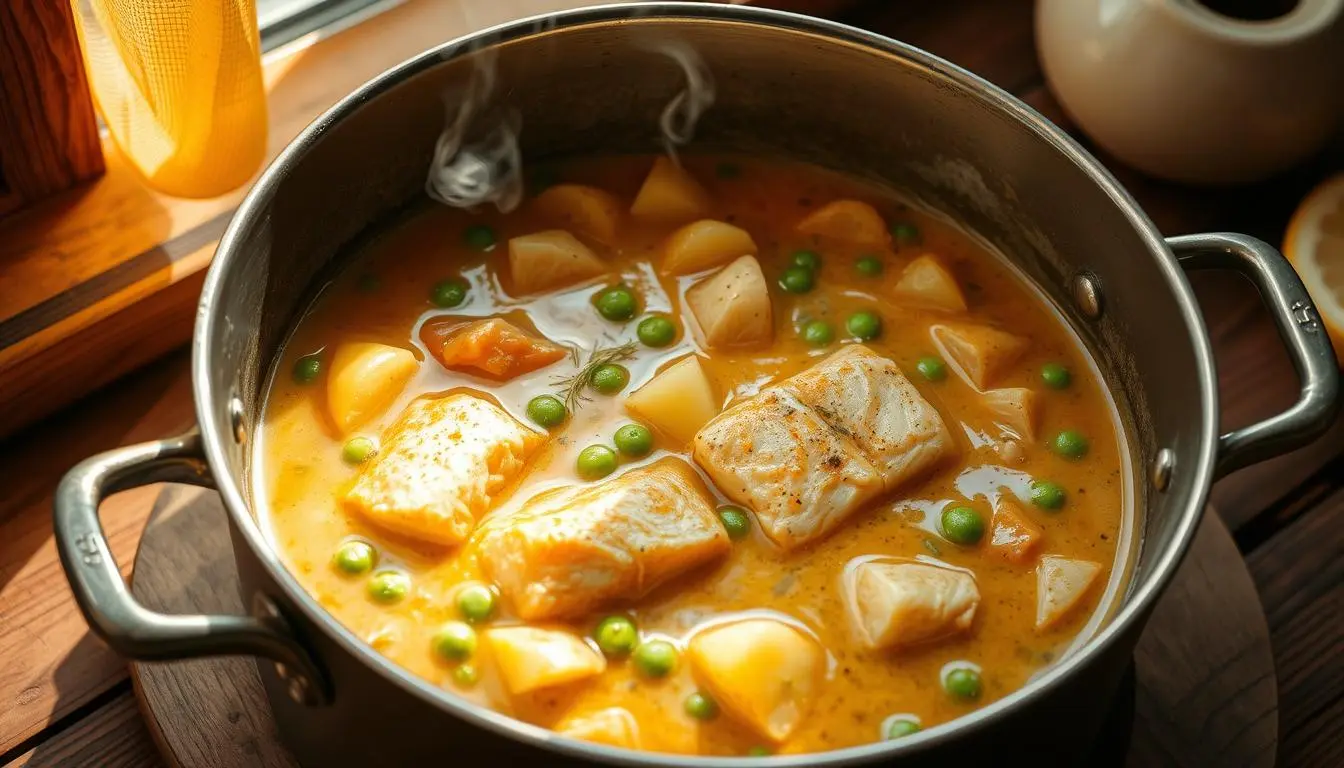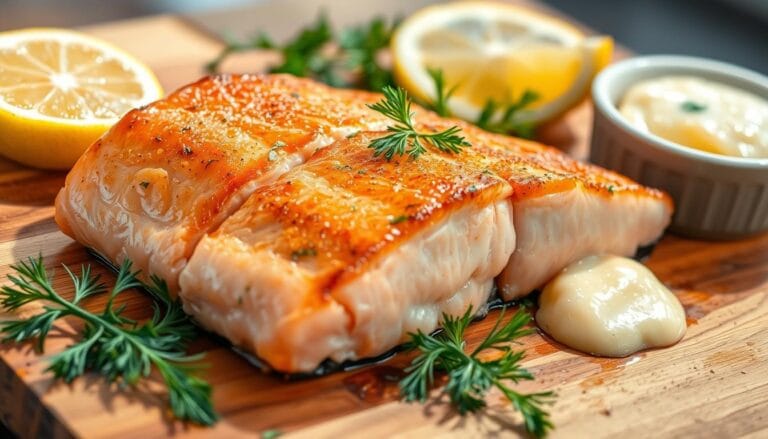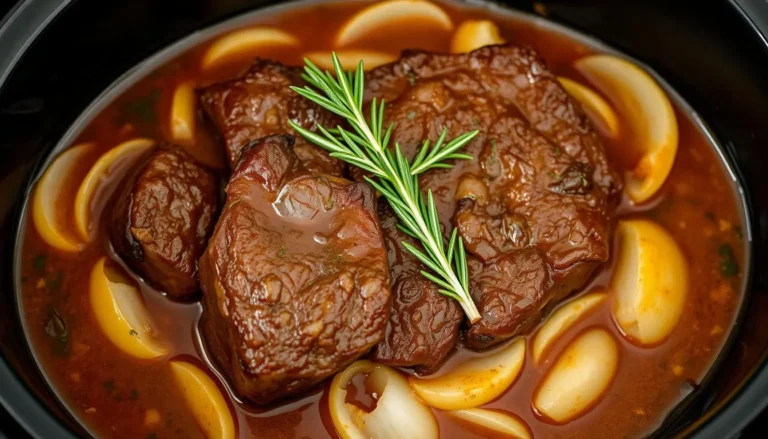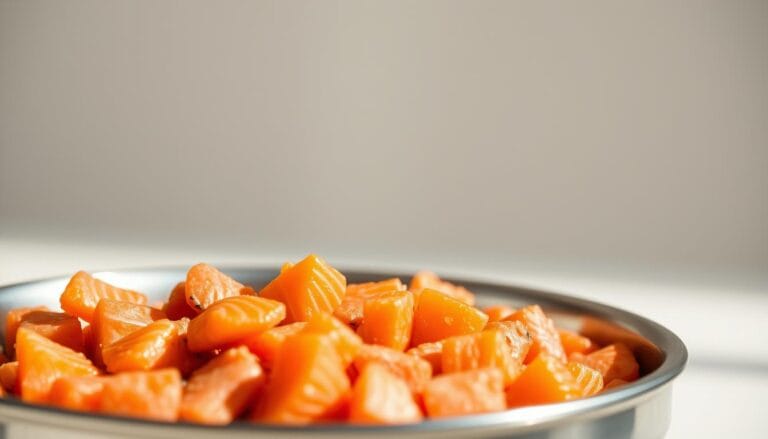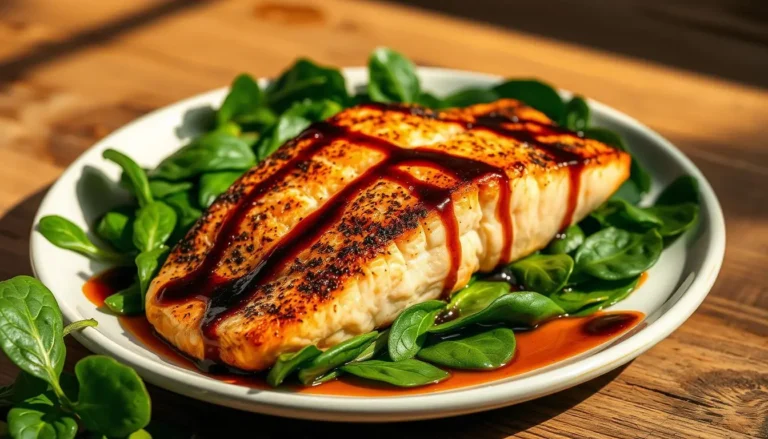How to Make the Best Salmon Stew at Home
Growing up by the coast, salmon stew was more than food. It was a tradition that brought us together. The smell of cooking salmon, potatoes, and broth filled our kitchen, making lasting memories.
Salmon stew is the perfect mix of comfort and health. It turns simple ingredients into a meal that warms your heart and body. Whether you love seafood or just want a healthy meal, this stew will please your taste buds.
The beauty of salmon stew is its simplicity. With a few ingredients, you get a meal full of protein, nutrients, and flavor. It’s great for family dinners or cozy nights by the fire.
Table of Contents
Introduction to Traditional Salmon Stew
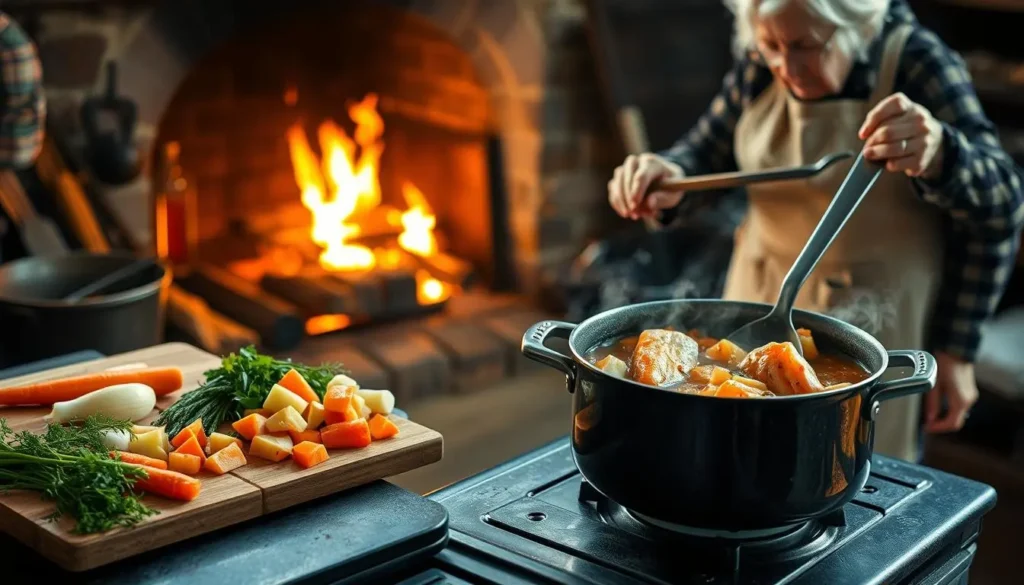
Seafood cuisine is rich and varied, with stewed salmon being a favorite across cultures. This dish has its roots in maritime communities. There, fresh salmon was turned into hearty meals with simple ingredients.
Salmon stew is more than food; it connects us to our coastal heritage. It has traveled from Nordic coasts to North American fishing towns. Home cooks and chefs have shaped it over the years.
Cultural Roots and Significance
The origins of traditional stewed salmon are found in several key regions:
- Nordic countries like Finland, where Lohikeitto is a classic salmon soup
- Pacific Northwest Native American tribes with long salmon fishing traditions
- Coastal European fishing communities
What Makes This Recipe Unique
Your salmon chowder is special because of its versatility and rich flavors. It’s different from other seafood stews because of its balance. Fresh salmon, aromatic veggies, and the right seasonings make it unforgettable.
Nutritional Powerhouse
This stew is not just tasty; it’s also good for you:
- It’s a high-quality protein source
- Rich in omega-3 fatty acids
- Packed with essential vitamins and minerals
- It’s a low-calorie meal option
With about 364 calories per serving, it’s both satisfying and nutritious. It’s perfect for a comforting meal or a healthy dinner.
Essential Ingredients for Perfect Salmon Stew

Making a great salmon stew begins with picking the right ingredients. Knowing each part’s role is key for a tasty meal.
The main ingredients for a top-notch salmon stew are:
- Fresh salmon fillet (1 lb, cut into 1-inch pieces)
- Aromatic vegetables like leeks and red bell peppers
- Zucchini for added texture
- Tomato paste and cherry tomatoes
- Fish stock or bouillon cubes
- Coconut milk or heavy cream
Seasoning is crucial for enhancing your salmon stew. Here are the essential spices and herbs:
- Dried thyme
- Fresh cilantro
- Chili flakes
- Salt and ground black pepper
- Ground saffron (optional)
Each ingredient brings special flavors and health benefits. Salmon is a great protein source, and veggies add vitamins and minerals.
| Ingredient | Quantity | Nutritional Benefit |
|---|---|---|
| Salmon | 1 lb | 16g protein, omega-3 fatty acids |
| Leeks | 2 cups | Fiber, vitamin K |
| Red Bell Peppers | 2 whole | Vitamin C, antioxidants |
| Coconut Milk | 14 oz | Healthy fats, creamy texture |
Pro tip: Use fresh, quality ingredients. Feel free to tweak seasonings to your liking.
Kitchen Equipment and Preparation Tips
To make a tasty salmon stew with potatoes, you need the right tools and preparation tips. Professional chefs say the right equipment makes cooking fun and easy.
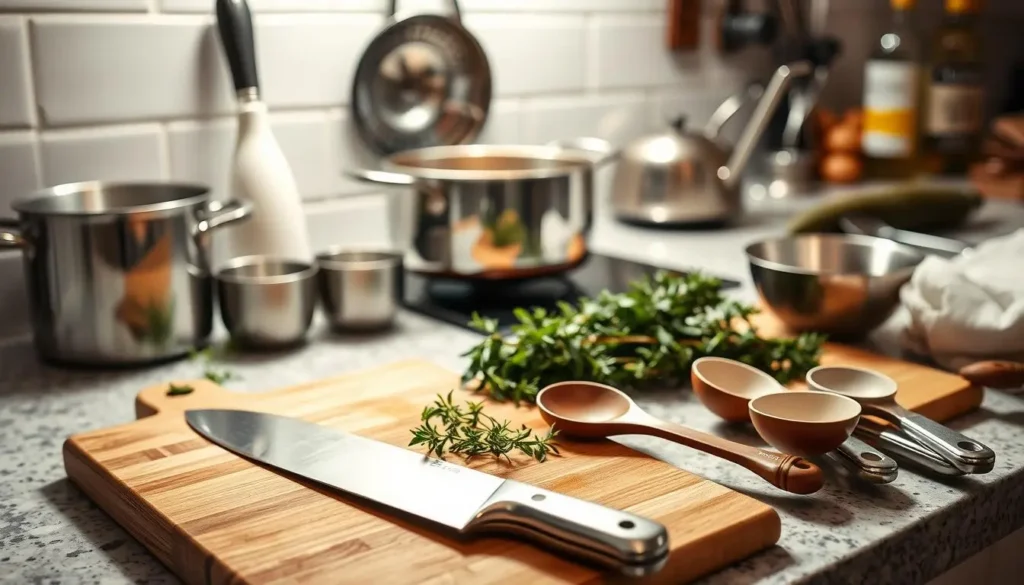
For a perfect salmon stew, you need special cookware and preparation methods. These help you make a delicious meal quickly.
Essential Cookware for Salmon Stew
- Large heavy stockpot or Dutch oven
- Sharp chef’s knife
- Cutting board
- Wooden spoon
- Instant-read thermometer
Ingredient Preparation Techniques
When making your salmon stew, focus on cutting ingredients right. Cut salmon into 1-inch cubes for even cooking. Cut potatoes and veggies into the same size for a good texture.
Time-Saving Kitchen Tools
| Tool | Purpose | Benefit |
|---|---|---|
| Food processor | Chopping vegetables | Saves preparation time |
| Kitchen scale | Precise ingredient measurement | Ensures recipe consistency |
| Offset spatula | Handling delicate fish | Prevents salmon from breaking |
Professional cooks say good tools make cooking better. An instant-read thermometer checks salmon’s temperature, so it doesn’t get overcooked.
Pro Preparation Tips
- Prep ingredients before starting cooking
- Use sharp knives for clean cuts
- Keep tools within easy reach
- Organize workspace before beginning
With the right tools and preparation, you’ll make a delicious salmon stew. It will impress everyone.
Selecting the Best Salmon for Your Stew
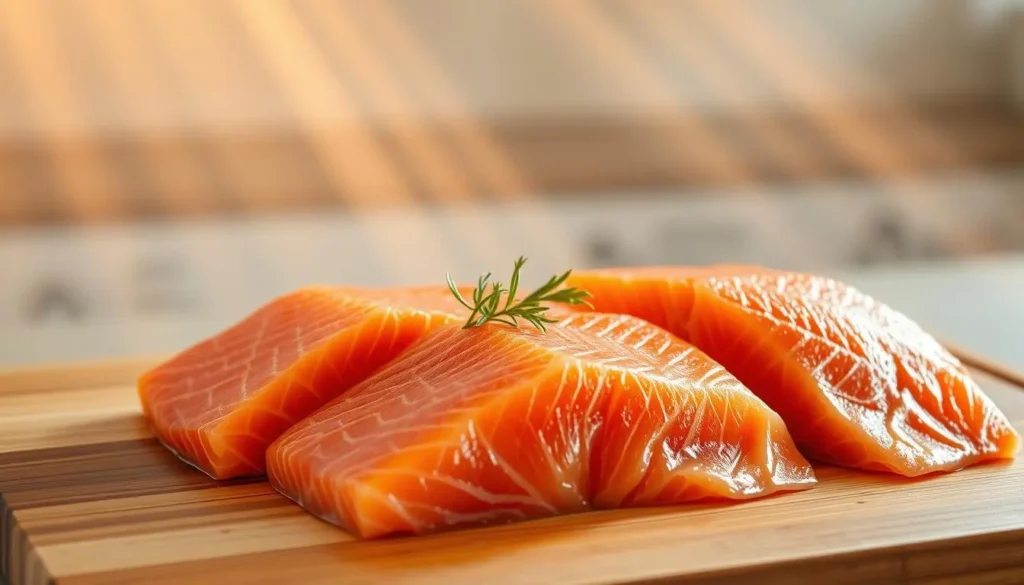
Choosing the right salmon is crucial for your stew. Not all salmon is the same. Knowing how to pick the best fish will make your dish stand out.
Here are the key things to consider when picking salmon for your stew:
- Opt for skinless, boneless salmon fillets
- Cut salmon into uniform 1.5-inch cubes for consistent cooking
- Prioritize Atlantic or Norwegian salmon for a milder flavor profile
Fresh salmon is key to a great stew. Look for fish with these qualities:
- Bright, vibrant color without brown spots
- Firm texture that springs back when touched
- Clean, oceanic smell without strong fishy odors
“The quality of your salmon determines the soul of your stew.” – Culinary Wisdom
Sustainable fishing is important. Choose salmon that’s been caught responsibly. Wild-caught Alaskan salmon is top-notch and helps the ocean.
Pro tip: If fresh salmon is hard to find, frozen salmon is a good choice. Just thaw it right to keep it tasty and tender.
Fresh vs. Frozen Salmon Debate
Choosing between fresh and frozen salmon can greatly affect your salmon stew’s taste and quality. Knowing the differences in salmon selection is key to making a delicious stew.
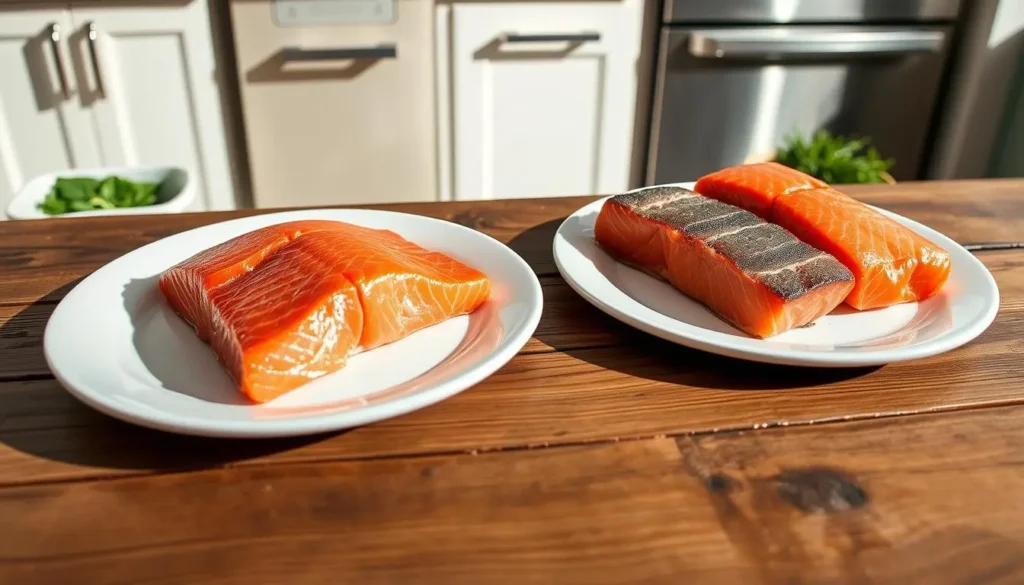
Many salmon enthusiasts argue over fresh versus frozen fish for their stews. Both have benefits that can improve your cooking experience.
Comparing Fresh and Frozen Salmon
| Characteristic | Fresh Salmon | Frozen Salmon |
|---|---|---|
| Availability | Seasonal | Year-round |
| Price | Higher | More affordable |
| Nutritional Value | Highest when just caught | Preserved through flash-freezing |
Storage Guidelines
- Fresh salmon should be used within 1-2 days of purchase
- Frozen salmon can be stored for up to 3 months in the freezer
- Always keep salmon refrigerated at 40°F or below
Thawing Methods
- Refrigerator thawing: Safest method, takes 24 hours
- Cold water thawing: Faster, requires sealed packaging
- Microwave thawing: Use immediately after thawing
When using frozen salmon, make sure it’s fully thawed and pat dry before cooking. Pro tip: Experts say flash-frozen salmon is as nutritious as fresh. The USDA suggests eating 8 ounces of fish a week.
The key is proper handling and cooking technique, regardless of whether you choose fresh or frozen salmon.
By following these tips, you can pick and prepare salmon for a stew that will wow your loved ones.
Base Vegetables and Aromatics

Learning how to make salmon stew starts with understanding base vegetables and aromatics. These ingredients are the heart of your dish. They turn a simple recipe into a true masterpiece.
Choosing the right vegetables is key. Your base should include:
- Onions (2 cups chopped)
- Celery (1 cup thinly sliced)
- Carrots
- Garlic
Cooking these vegetables is an art. Start by sautéing onions and celery in 2 tablespoons of olive oil for 5-8 minutes. This makes them translucent and releases their natural sweetness. This step is crucial for a rich flavor in your salmon stew.
| Vegetable | Preparation Time | Flavor Contribution |
|---|---|---|
| Onions | 5-8 minutes | Sweetness and depth |
| Celery | 5-8 minutes | Aromatic base |
| Garlic | 1-2 minutes | Intense flavor |
Aromatics like bay leaves, fresh thyme, and parsley can make your salmon stew stand out. These herbs add depth and brightness to the taste. Your stew will be unforgettable.
Pro tip: Add 1 tablespoon of tomato paste during sautéing. It boosts the umami flavor and makes your stew’s base more robust.
Creating the Perfect Broth Foundation
Making a great tomato soup with salmon begins with a strong broth base. The right stock can turn your soup into something special. It adds depth and character to every bite.
Your broth is the key flavor base for your tomato soup with salmon. Professional chefs know that the stock’s quality greatly affects the dish’s taste.
Stock Selection Strategies
When making your salmon-based soup, think about these stock choices:
- Fish broth (recommended for authentic flavor)
- Vegetable stock (lighter alternative)
- Chicken stock (provides richer undertones)
Seasoning Combinations
Boost your broth with smart seasoning techniques:
- Use white wine to add complexity
- Incorporate fresh herbs like dill or parsley
- Include aromatic vegetables for depth
“The secret to an incredible soup lies in its foundation” – Culinary Wisdom
Pro tip: For fish broth in your tomato soup with salmon, aim for a simmer of 30-45 minutes. This gets the most flavor out without losing the fish’s delicate taste.
Step-by-Step Salmon Stew Recipe
Making the perfect salmon stew needs careful steps and attention. Wild-caught salmon gives the best taste and quality. Here’s how to make a delicious salmon stew that will wow your loved ones.
- 150g fresh salmon fillet
- Assorted vegetables (leek, celery, carrots)
- 2 garlic cloves
- 150ml whipping cream
- Fresh herbs (thyme, parsley)
- Seasonings
Begin by chopping your veggies. Cut the leek, celery, and carrots into small pieces. Precision in cutting ensures even cooking and balanced flavors. Heat a large pot and add a small amount of butter to sauté the vegetables until they become soft and fragrant.
When adding the salmon, do it carefully. Cook the fish for 2-3 minutes until it starts to flake. This stew cooks for about 45 minutes, with 25 minutes for prep and 20 minutes for cooking.
Here are some pro tips for the best salmon stew:
- Use wild-caught salmon for best flavor
- Don’t overcook the salmon
- Season generously
- Add cream for richness
Nutritional highlights of this salmon stew recipe include:
- 539 calories per serving
- 27 grams of protein
- 51 grams of carbohydrates
- 26 grams of fat
When serving, pair your salmon stew with crusty bread and white wine. You can store it in the fridge for up to 4 days, great for meal prep.
Mastering the Cooking Process
Learning to make salmon stew needs precision and care. The cooking process can turn fresh ingredients into a tasty meal or a letdown.
Cooking salmon stew requires watching temperature and timing closely. Professional chefs know that keeping the heat low is key. This helps keep the fish’s texture and taste just right.
Temperature Control Techniques
When making salmon stew, controlling temperature is key. The best cooking temperature for salmon is between 120°F and 145°F:
- Medium-rare salmon: 120°F
- Safe cooking temperature: 145°F
- Recommended simmering heat: Low to medium
Precise Timing Guidelines
Timing is crucial when making salmon stew. Different cooking methods need different times:
- Slow roasting at 275°F: 15-35 minutes
- Sous vide method: 30 minutes
- Pan-seared approach: 12 minutes total
- Recommended total stew cooking time: 30-40 minutes
Your aim is to make a perfectly tender salmon stew. It should be so tender it melts in your mouth. And it should keep the fish’s natural flavors and nutrients.
Adding Potatoes and Other Vegetables
Making a great salmon stew with potatoes means picking the right veggies. The right vegetables can turn a simple stew into a healthy and tasty meal.
For your salmon stew, choose vegetables that go well with the salmon. Here are some good picks:
- Potatoes: Use 2 medium potatoes, chopped into bite-sized cubes
- ½ carrot for added sweetness and texture
- 10 snow peas for a fresh, crisp element
- 100g shimeji mushrooms for depth of umami flavor
Getting your veggies ready is key. Start by boiling potatoes and carrots until they’re tender but still firm. This keeps them from getting too soft during the stew’s cooking.
Here are some tips for adding veggies to your stew:
- Cut vegetables into uniform sizes for even cooking
- Add more delicate vegetables like snow peas closer to the end of cooking
- Use 1 tbsp of cooking oil to sauté vegetables before adding to the broth
- Microwave vegetables at 600W for about 3 minutes as a quick preparation method
The right mix of veggies can make your salmon stew amazing. Try different combinations to find the perfect flavor and nutrition for you.
Seasoning and Spice Combinations
Making the perfect salmon stew is all about finding the right balance of seasonings. The right spices can turn a simple dish into a work of art. They add depth and complexity to every bite.
Seasoning salmon stew is an art. It’s about knowing how spices work with the fish. You want to boost the salmon’s flavor without overpowering it.
Traditional Spice Blends
Classic seasonings give salmon stew a bold taste. Here are some must-haves:
- Smoked paprika for depth
- Bay leaves for subtle earthiness
- Black pepper for warmth
- Sea salt to enhance natural flavors
Regional Variations
Every region has its own twist on salmon stew spices. Let’s explore some interesting flavors:
| Region | Signature Spices | Flavor Profile |
|---|---|---|
| Pacific Northwest | Dill, thyme | Fresh, herbal |
| Mediterranean | Saffron, oregano | Warm, aromatic |
| Scandinavian | Caraway, cardamom | Intense, complex |
Try out these spice mixes to make your own special salmon stew. Remember, the key is balance and personal taste.
How to Achieve the Perfect Consistency
Getting the right consistency for stewed salmon is all about technique and understanding. The thickness of your stew affects its flavor and how it tastes. Chefs know that a good consistency makes a dish unforgettable.
To get the perfect texture for your stewed salmon, try these methods:
- Simmering longer to naturally thicken the broth
- Adding cornstarch or breadcrumbs as thickening agents
- Controlling liquid levels throughout cooking
- Using starchy vegetables like potatoes to provide natural density
Start with 2 ½ – 3 ½ cups of stock when making your stewed salmon. Adjust the amount based on how thick you want it. If it’s too thin, let it simmer uncovered to reduce liquid. For a quick fix, mix 1 tablespoon of cornstarch with cold water, then stir it into the stew.
Texture is important in stewed salmon. You want a rich, slightly thick broth that covers the fish and veggies well. Aim for a consistency like a light cream soup – thick enough to coat but still pourable.
Pro tip: Let your stewed salmon rest for 10-15 minutes after cooking. This allows flavors to meld and the broth to naturally thicken.
Different ingredients can change your stew’s texture. For example, potatoes release starches that help thicken it. Using 1 pound of russet potatoes will make your stew thicker than other potatoes.
Serving Suggestions and Accompaniments
Your salmon stew recipe is ready to impress. The right sides can make a big difference. They can turn a simple meal into a special experience.
Here are some top side dish choices for your salmon stew:
- Crusty artisan bread for dipping
- Roasted seasonal vegetables
- Creamy potato salad
- Fresh green salad with herb vinaigrette
- Steamed rice with lemon zest
Choosing the right garnishes can really make your salmon stew stand out. Fresh herbs like dill, parsley, or chives add color and flavor. Add them just before serving for a beautiful look.
Pair your salmon stew with a crisp white wine or a light drink. The right choice can balance the rich flavors of the stew. It makes for a complete and enjoyable meal.
Here are some quick tips for serving your salmon stew:
- Serve hot right after cooking
- Use wide, shallow bowls to show off the stew
- Garnish with fresh herbs
- Offer crusty bread on the side
With these tips, your salmon stew will taste great and look amazing. Try different sides to find your favorite!
Storage and Reheating Guidelines
Keeping your salmon stew fresh is key. You need to store it right and reheat it carefully. This way, you can enjoy your meal safely and keep its great taste and texture.
Proper Storage Methods
Here are the important steps for storing your salmon stew:
- Cool the stew completely before storing
- Use airtight containers to prevent contamination
- Refrigerate within 2 hours of cooking
- Store in the refrigerator for up to 3 days
Safe Storage Recommendations
| Storage Location | Maximum Storage Time | Food Safety Notes |
|---|---|---|
| Refrigerator | 1-2 days | Keep below 40°F |
| Freezer | 2-3 months | Use freezer-safe container |
Best Reheating Practices
Reheating salmon stew needs gentle care. You want to avoid overcooking and keep its texture soft. There are different ways to warm it up and bring back its flavor.
- Stovetop: Reheat on medium heat, stirring occasionally
- Oven: Warm at 275°F for 10-15 minutes
- Microwave: Use medium power for 1-2 minutes
Always check the salmon stew’s internal temperature. It should be 145°F to be safe. Don’t reheat it too many times. This can make the stew less tasty and increase the chance of bacteria.
Recipe Variations and Adaptations
Transform your salmon chowder with simple swaps and creative techniques. Wild salmon is packed with omega-3s, making it a great base. Try using parsnips or sweet potatoes instead of potatoes for a nutritional boost and unique flavors.
Need to follow dietary restrictions? The recipe for salmon chowder has you covered. Use plant milk for a dairy-free option or coconut milk for a lighter version. If you’re on a budget, use regular salmon and add liquid smoke for that smoky taste.
Change up the veggies to change the flavor of your chowder. Add carrots for vitamin A, celery for health benefits, or try herbs like dill, thyme, or basil. You can also swap salmon for trout or sea bass for a different taste without losing flavor.
Your creativity in the kitchen has no limits with this recipe. It’s perfect for the Autoimmune Paleo Protocol or just trying something new. The best recipes are those that fit your taste and dietary needs.
FAQ
What makes salmon stew different from other seafood stews?
How do I choose the best salmon for my stew?
Can I make salmon stew with frozen salmon?
What are the key ingredients for a traditional salmon stew?
How long can I store leftover salmon stew?
Is salmon stew healthy?
Can I make salmon stew dairy-free or gluten-free?
What are some good side dishes to serve with salmon stew?
Did You Try Our Recipe?
There are no reviews yet. Be the first one to write one.

